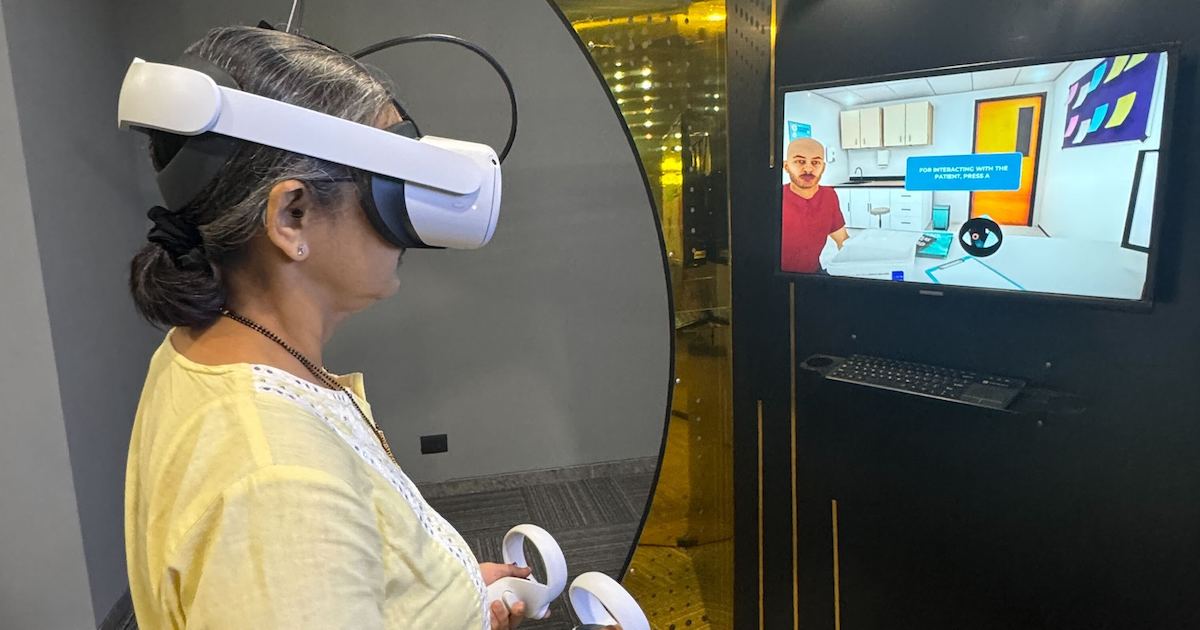
A nursing training facility in India has recently opened, which could be the first to be augmented by virtual reality technology.
Healthcare VR developer MediSim VR has partnered with Kusum Dhirajlal (KD) Hospital to establish the Virtual Reality Health Lab.
WHAT IT’S ABOUT
Located at the 300-bed multispecialty hospital in Ahmedabad, a city in the western state of Gujarat in India, the nursing skill training centre is equipped with VR simulators that provide an immersive real-world-like environment for practising medical procedures and developing clinical skills.
In an interview with Mobihealth News, Riddhi Baid, business development head at MediSim VR, shared that the training laboratory features a comprehensive, curated module library of essential skills endorsed by the Medical Council of India, the United Kingdom’s General Medical Council, and the American Medical Council.
“We cover essential skills required for all healthcare providers, including basic patient care skills such as assessing vital signs, proper wound care techniques, insertion of catheters, IV cannulas, and many more.”
Inaugurated in June, the VR training facility serves as a Centre of Excellence that aims to improve nursing training standards to boost productivity, address skill gaps, and align training and research with industry needs.
As a CoE, it hosts training programmes, research, conferences, expert sessions, international events, trainers’ training, and skills training. It also extends access to VR training to nursing colleges around Gujarat.
“By integrating this state-of-the-art simulation training technology into our curriculum, we [do] not only enhance our students’ learning experience but also serve as a training hub for healthcare professionals across Gujarat. As a [CoE], the MediSim VR Lab will play a significant role in upskilling nursing students,” Dr Anuja Desai, executive director of KD Hospital, said in an official media release.
MediSim VR and KD Hospital initially partnered in January to integrate VR technology into the training programme of the KD Institute of Nursing.
WHY IT MATTERS
The Indian Nursing Council estimates that there are about 3.3 million registered nurses in the country. This equates to 1.96 nurses per thousand persons, which falls short of the World Health Organization’s recommended ratio of three nurses per thousand population.
Besides this shortage, there is also a need to train and upskill nurses, particularly in areas outside urban centres where resources are limited.
Baid believes the integration of VR in nursing education can help address this worsening issue. It both enhances the quality of training and standardises training across institutions.
“Moreover, by reducing the dependency on traditional clinical placements, VR can alleviate resource constraints and accommodate larger cohorts of students.”
Aside from nursing, VR can also benefit learners in other areas of medical education, such as surgery and emergency medicine.
“VR is increasingly used in therapy and pain management, offering innovative ways to help patients manage chronic pain and recover from injuries.”
Patient education is also an area where VR can potentially provide value, helping patients understand their conditions, treatment options, and surgical procedures, according to Bair.
THE LARGER TREND
The recent pandemic saw nursing education institutions around Asia increasingly adopt VR technology to continue conducting classes while meeting safety protocols.
In Hong Kong, for example, the Hong Kong Polytechnic University developed the VR-based Virtual Hospital learning system – a first of its kind in the city – that simulates real-life hospital ward scenarios in a game format.
Even as the pandemic subsided, institutions like the Singapore General Hospital still saw VR’s value in augmenting nursing education. Recently, i tdeveloped the VR module IV NIMBLE, together with Serious Games Asia and sensor technology developer Microtube Technologies, to help upskill nurses in IV cannulation.






